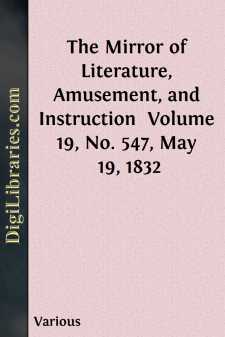Categories
- Antiques & Collectibles 13
- Architecture 36
- Art 48
- Bibles 22
- Biography & Autobiography 813
- Body, Mind & Spirit 142
- Business & Economics 28
- Children's Books 17
- Children's Fiction 14
- Computers 4
- Cooking 94
- Crafts & Hobbies 4
- Drama 346
- Education 46
- Family & Relationships 57
- Fiction 11829
- Games 19
- Gardening 17
- Health & Fitness 34
- History 1377
- House & Home 1
- Humor 147
- Juvenile Fiction 1873
- Juvenile Nonfiction 202
- Language Arts & Disciplines 88
- Law 16
- Literary Collections 686
- Literary Criticism 179
- Mathematics 13
- Medical 41
- Music 40
- Nature 179
- Non-Classifiable 1768
- Performing Arts 7
- Periodicals 1453
- Philosophy 64
- Photography 2
- Poetry 896
- Political Science 203
- Psychology 42
- Reference 154
- Religion 513
- Science 126
- Self-Help 84
- Social Science 81
- Sports & Recreation 34
- Study Aids 3
- Technology & Engineering 59
- Transportation 23
- Travel 463
- True Crime 29
The Mirror of Literature, Amusement, and Instruction Volume 19, No. 547, May 19, 1832
by: Various
Categories:
Description:
Excerpt
WILTON CASTLE.
Wilton Castle.Here is one of the ivy-mantled relics that lend even a charm to romantic nature on the banks of the Wye. Its shattered tower and crumbling wall, combine with her wild luxuriance, to form a scene of great picturesque beauty, though, as Gilpin observes, "the scene wants accompaniments to give it grandeur."
These ruins stand opposite to Ross, on the western bank of the Wye. The Castle was for several centuries the baronial residence of the Greys of the south, who derived from it their first title, and who became owners in the time of Edward the First. It may therefore be presumed to have been one of the strongholds, in the great struggles for feudal superiority with Wales, which were commenced by Edward, whose "active and splendid reign may be considered as an attempt to subject the whole island of Great Britain to his sway." Or, in earlier times, being situated on the ancient barrier between England and Wales, it may have been a station of some importance, from its contiguity to Hereford, which city was destroyed by the Welsh, but rebuilt and fortified by Harold, who also strengthened the castle. The whole district is of antiquarian interest, since, at the period of the Roman invasion, Herefordshire was inhabited by the Silures, who also occupied the adjacent counties of Radnor, Monmouth, and Glamorgan, together with that part of Gloucestershire which lies westward of the Severn. The Silures, in conjunction with the Ordovices, or inhabitants of North Wales, retarded, for a considerable period, the progress of the Roman victors, whose grand object seems to have been the conquest of these nations, who had chosen the gallant Caractacus as their chieftain, and resolutely exhausted every effort in defence of the independence of their country.
The present demolished state of the Castle is referred to the Royalist Governors of Hereford, by whose orders it was burnt to the bare walls during the reign of Charles I. in the absence of its then possessor, Sir J. Brydges.
The scenery of the WYE, at this point is thus described by tourists: "From Hereford to Ross, its features occasionally assume greater boldness; though more frequently their aspect is placid; but at the latter town wholly emerging from its state of repose," it resumes the brightness and rapidity of its primitive character, as it forms the admired curve which the churchyard of Ross commands. The celebrated spire of Ross church, peeping over a noble row of elms, here fronts the ruined Castle of Wilton, beneath the arches of whose bridge, the Wye flows through a charming succession of meadows, encircling at last the lofty and well-wooded hill, crowned with the majestic fragments of Gooderich Castle, and opposed by the waving eminences of the forest of Dean. The mighty pile, or peninsula, of Symonds' Rock succeeds, round which the river flows in a circuit of seven miles, though the opposite points of the isthmus are only one mile asunder. Shortly afterwards, the Wye quits the county, and enters Monmouthshire at the New Wear....












